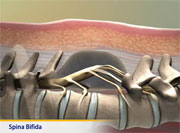
Spina Bifida
What is spina bifida?
Spina bifida is a birth defect that happens when the spinal column does not completely close before birth. An opening is left between the bones of the spine (vertebrae) that allows spinal membranes or even the spinal cord to bulge out.
There are two types of spina bifida. The first type is called spina bifida occulta. With this type, there is an opening in the spine, but the spinal cord does not bulge out and there is no damage to the nerves and spinal cord. Often this type of spina bifida goes unnoticed and may need no treatment.
The second type of spina bifida is called spina bifida manifesta and there are two categories. The first is meningocele, where the protective sac around the spinal cord has pushed through the opening in the spine. The second and more severe is myelomeningocele where the spinal cord sticks out and is not covered by skin.
How does it occur?
The causes of spina bifida are not well understood. The defect usually happens in the first month of pregnancy. Viruses, radiation, or exposure to some antiseizure medicines such as valproic acid and carbamazepine during pregnancy may be a cause. Women who have one child with spina bifida have a greater chance of having another child with the same problem.
It is known that women who take folic acid reduce the risk of having a baby with spina bifida. All women of childbearing age should talk with their healthcare provider about the need to take extra folic acid.
What are the symptoms?
The symptoms of spina bifida depend on how severely the spinal cord and nerves are damaged.
Children with the more severe form of spina bifida may have:
- some paralysis in the legs
- learning disabilities
- trouble controlling their bowel and bladder
- kidney problems
- hydrocephalus, which is fluid building up around the brain.
Spina bifida rarely causes the child to be mentally disabled.
How is it diagnosed?
There are tests that can be done during pregnancy to check if the baby has spina bifida. If a baby is born with a meningocele or myelomeningocele, the bulge in the back can be seen.
How is it treated?
If only the protective sac around the spinal cord is sticking out and there is no nerve damage, chances are good that the child can have surgery to close the area and have a normal life. If the spinal cord is sticking out, the child's legs may be paralyzed. The amount of paralysis depends on where the opening is. The lower the opening is in the back, the less paralysis there is.
Besides surgery to close the area, treatment involves continually watching the child's growth and development.
Treatment may also include:
- waist or leg braces, walkers, crutches, and other equipment
- diet and bowel training
- bladder therapy or devices that help in bladder control.
Where can I get more information?
Parents of a child with spina bifida may need support in meeting their physical and emotional needs. Depending on physical and mental problems, children may need to attend a school that can meet their special needs.
You can get more information and find local support groups by calling The Spina Bifida Association of America at 800-621-3141 or visiting their Web site at http://www.sbaa.org
Last modified: 2011-04-28
Last reviewed: 2009-11-05

